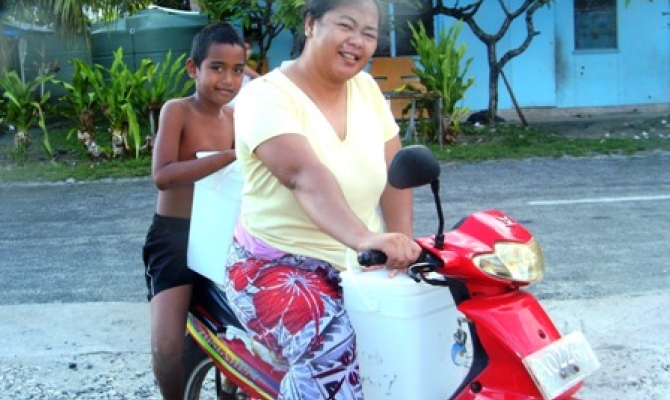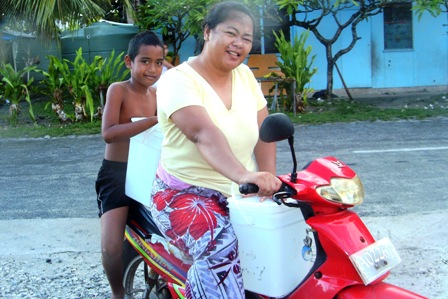
Climate Change Resilience
Reduced rainfall, possibly leading to drought, is forecast for several Pacific Islands.
It is likely that there will be below normal rainfall for a number of countries, which could lead to drought conditions. These countries are Vanuatu, Fiji, New Caledonia, Niue, Tonga and Papua New Guinea.
These countries are urged to take all necessary measures to mitigate the potential impacts of drought and El Niño. Impacts in each sector (water resources, agriculture, health, tourism, forestry, marine ecosystems) will vary in severity and are dependent on a number of factors.
"It is important for Pacific communities and for each national sector to appropriately act on the advice given by their National Meteorological Services regarding the El Niño event this year, every effort should go towards conservation of water and to minimise bush fires. Each Pacific island country and territory should exercise sustainable management of available water resources and ways to minimise the impacts of water shortages on other sectors such as agriculture and health," said Dr. Netatua Pelesikoti, Director of Climate Change of the Secretariat of the Pacific Regional Environment Program (SPREP).

Other islands where normal or below normal rainfall is forecast are the Marquesas, Wallis and Futuna, the Northern Cooks Islands and the Southern Cook Islands, Samoa, the Society Islands, the Solomon Islands and Tuamotu.
The El Niño conditions in the Pacific have continued to strengthen over the last few months and are likely to persist into early 2016. The atmospheric and oceanic indicators used to monitor the Pacific are consistent with patterns typically seen during an El Niño.
El Niño conditions are associated with strong seasonal changes to rainfall and cyclone patterns across the Pacific.
Indicators in July alone have reached levels observed in 1997 and 1982 where strong El Niño were observed, according to the Island Climate Update, which is provided by Pacific Island National Meteorological Services, SPREP and NIWA.
The 1997 El Niño caused severe drought and food shortages in Papua New Guinea, Solomon Islands, the Federated States of Micronesia and the Marshall Islands. There were also more tropical cyclones than usual in the eastern Pacific over the October 1997- April 1998 period.
Updates on rainfall across the Pacific are provided at the beginning of each month. Further guidance on the upcoming cyclone season will be issued by Pacific Island National Meteorological Services in October.
For more information regarding El Niño impacts in your respective country, please contact your local meteorological service.
What is El Niño?
The original definition of El Niño can be traced back to the eighteenth or nineteenth century when Peruvian sailors used the term to describe a warm southward current that appeared annually near Christmas off the Peruvian coast. In an El Niño event, surface waters in the central and eastern Pacific become significantly warmer than average, extreme climate and weather patterns govern across the Pacific Ocean resulting in fluctuating droughts and floods globally; and affecting agriculture and fisheries in the region. The pattern sets up when easterly trade winds in the Pacific falter and allow giant waves of warm water to drift from the western Pacific toward the Americas.
El Niño is associated with shifts in global rainfall and tropical cyclone activity. Usually El Niño is characterised with a shift in the cyclone activity to the east near Tahiti.
El Niño Impacts in the Pacific
El Niño events have resulted in water shortages and drought in American Samoa, Fiji, Kiribati, Marshall Islands, Federated States of Micronesia, Papua New Guinea, Samoa and Tonga. Drought often threatens water and food security in the Pacific islands. Most Pacific island countries depend on the agricultural sector for food, income and employment. The agricultural sector is very susceptible and vulnerable to adverse climate fluctuations. The 1997-98 El Niño is recognised as one of the most damaging ever in the Pacific and one of the worst disasters ever to hit the region having severe socioeconomic impacts.
It is likely that there will be below normal rainfall for a number of countries, which could lead to drought conditions. These countries are Vanuatu, Fiji, New Caledonia, Niue, Tonga and Papua New Guinea.
These countries are urged to take all necessary measures to mitigate the potential impacts of drought and El Niño. Impacts in each sector (water resources, agriculture, health, tourism, forestry, marine ecosystems) will vary in severity and are dependent on a number of factors.
"It is important for Pacific communities and for each national sector to appropriately act on the advice given by their National Meteorological Services regarding the El Niño event this year, every effort should go towards conservation of water and to minimise bush fires. Each Pacific island country and territory should exercise sustainable management of available water resources and ways to minimise the impacts of water shortages on other sectors such as agriculture and health," said Dr. Netatua Pelesikoti, Director of Climate Change of the Secretariat of the Pacific Regional Environment Program (SPREP).

Transporting of water in Tuvalu during the drought in 2011
Other islands where normal or below normal rainfall is forecast are the Marquesas, Wallis and Futuna, the Northern Cooks Islands and the Southern Cook Islands, Samoa, the Society Islands, the Solomon Islands and Tuamotu.
The El Niño conditions in the Pacific have continued to strengthen over the last few months and are likely to persist into early 2016. The atmospheric and oceanic indicators used to monitor the Pacific are consistent with patterns typically seen during an El Niño.
El Niño conditions are associated with strong seasonal changes to rainfall and cyclone patterns across the Pacific.
Indicators in July alone have reached levels observed in 1997 and 1982 where strong El Niño were observed, according to the Island Climate Update, which is provided by Pacific Island National Meteorological Services, SPREP and NIWA.
The 1997 El Niño caused severe drought and food shortages in Papua New Guinea, Solomon Islands, the Federated States of Micronesia and the Marshall Islands. There were also more tropical cyclones than usual in the eastern Pacific over the October 1997- April 1998 period.
Updates on rainfall across the Pacific are provided at the beginning of each month. Further guidance on the upcoming cyclone season will be issued by Pacific Island National Meteorological Services in October.
For more information regarding El Niño impacts in your respective country, please contact your local meteorological service.
What is El Niño?
The original definition of El Niño can be traced back to the eighteenth or nineteenth century when Peruvian sailors used the term to describe a warm southward current that appeared annually near Christmas off the Peruvian coast. In an El Niño event, surface waters in the central and eastern Pacific become significantly warmer than average, extreme climate and weather patterns govern across the Pacific Ocean resulting in fluctuating droughts and floods globally; and affecting agriculture and fisheries in the region. The pattern sets up when easterly trade winds in the Pacific falter and allow giant waves of warm water to drift from the western Pacific toward the Americas.
El Niño is associated with shifts in global rainfall and tropical cyclone activity. Usually El Niño is characterised with a shift in the cyclone activity to the east near Tahiti.
El Niño Impacts in the Pacific
El Niño events have resulted in water shortages and drought in American Samoa, Fiji, Kiribati, Marshall Islands, Federated States of Micronesia, Papua New Guinea, Samoa and Tonga. Drought often threatens water and food security in the Pacific islands. Most Pacific island countries depend on the agricultural sector for food, income and employment. The agricultural sector is very susceptible and vulnerable to adverse climate fluctuations. The 1997-98 El Niño is recognised as one of the most damaging ever in the Pacific and one of the worst disasters ever to hit the region having severe socioeconomic impacts.